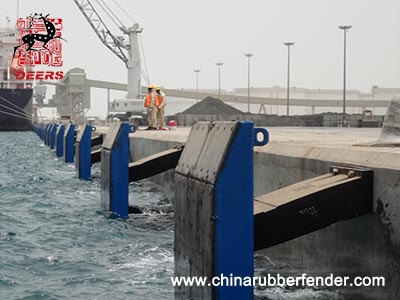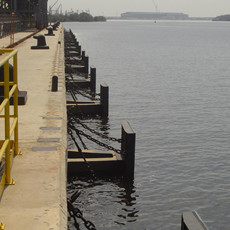Dock fender systems design – affecting factors
Since the purpose of dock fender systems is to absorb the energy of a berthing ship, it is necessary to examine the factors that make up the total energy package, which is affecting dock fender systems design.
- Weight of the vessel in displacement tons.
- Berthing velocity normal to the dock.
- The angle of approach.
- Hydraulic Effect.
- Dock design.

1.Weight of vessel
Usually, deadweight tonnage (DWT) or displacement tonnage is used to refer to the weight of a ship. Displacement tonnage is a more accurate number used to calculate kinetic energy because it is the total weight of the ship and its cargo and equipment. If the deadweight tonnage is known, multiply the DWT by 1.3 to obtain an accurate approximation of the displacement tonnage.
2.Berthing Velocity
Since the kinetic energy of a ship is proportional to the square of the speed, it is important to accurately determine the speed. The speed of ships entering the dock is affected by many factors:
- the size of the vessel,
- the skill of the crew members,
- the wind and current conditions,
- And whether the ship is making unassisted berthing or if it is being assisted by tugs.
Since the ship’s speed is usually given in knots, it is necessary to convert it to feet/second as follows: knot x 1.09 = feet/second.
3.Angle of Approach
The angle at which the ship approaches the dock not only affects the effective speed but also affects which part of the ship makes initial contact with the dock. Usually, the ship will contact the dock near the bow or stern. In this case, the reaction force will cause the ship to produce rotational motion, and this rotational motion will dissipate part of the ship’s energy.
4.Hydraulic Effect
When determining the energy absorbed by the mudguard, the influence of water must also be considered. When the ship comes into contact with the dock and suddenly checks its movement, the amount of water moving with the ship increases the energy the ship has. Although there are many theories related to hydraulic effects, they all involve the ship’s length, beam, and draft.
5.Dock design
To choose the right size and type of Dock Fender, you must consider the design of the Dock.
If the docking station does not have a separate front system: the mudguard can be mounted directly on the surface of the docking station. Common methods of attaching fenders to this dock surface include:
- Festooning cylindrical fenders by suspending them with chains.
- Directly bolting Rectangular, Wing type, D Shaped or Trapezoidal fenders to the dock face.
For any fixing method, the fenders can be placed horizontally or diagonally, depending on the tide conditions and the type of vessel served by the terminal. In areas with relatively high tides, or on piers where barges and ships will be handled, it is good practice to install fenders diagonally to protect the larger pier surface.
For docks with a frontal protection system composed of piles and longitudinal rows: usually rectangular or trapezoidal fenders are installed between the dock surface and the longitudinal rows. The design strength of the dock will also affect the size and type of fenders used. Piers and dolphins supported by piles have certain limitations in design. In these cases, a fender system must be selected that can absorb the energy of the berthing ship and stay within the structural design constraints.
After determining the energy to be absorbed and the type of pier to be protected, the next step is to select the appropriate fender size and type to specify. In addition, the installation method of the mudguard can be determined.


